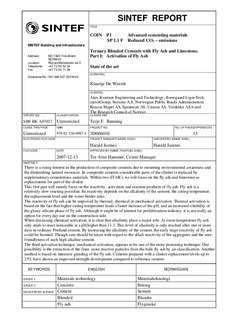| dc.contributor.author | De Weerdt, Klaartje | |
| dc.date.accessioned | 2017-02-22T08:13:51Z | |
| dc.date.available | 2017-02-22T08:13:51Z | |
| dc.date.created | 2017-02-10T08:47:21Z | |
| dc.date.issued | 2007-12-13 | |
| dc.identifier.isbn | 978-82-536-0987-4 | |
| dc.identifier.uri | http://hdl.handle.net/11250/2431670 | |
| dc.description.abstract | There is a rising interest in the production of composite cements due to mounting environmental awareness and the diminishing natural resources. In composite cements considerable parts of the clinker is replaced by supplementary cementitious materials. Within two STAR’s we will focus on the fly ash and limestone as replacements for part of the clinker.
This first part will mainly focus on the reactivity, activation and reaction products of fly ash. Fly ash is a relatively slow reacting pozzolan. Its reactivity depends on the alkalinity of the cement, the curing temperature, the replacement level and the water-binder ratio.
The reactivity of fly ash can be improved by thermal, chemical or mechanical activation. Thermal activation is based on the fact that higher curing temperature leads a faster increase of the pH, and an increased solubility of the glassy silicate phase of fly ash. Although it might be of interest for prefabrication industry, it is not really an option for every day use on the construction side.
When discussing chemical activation, it is clear that alkalinity place a major role. At room temperature fly ash only starts to react noticeable at a pH higher than 13.3. This level of alkalinity is only reached after one or more days in ordinary Portland cement. By increasing the alkalinity of the cement, the early stage reactivity of fly ash could be boosted. Though care should be taken with regard to the alkali reactivity of the aggregates and the user-friendliness of such high alkaline cement.
The third activation technique, mechanical activation, appears to be one of the more promising technique. One possibility is the extraction of the finer, more reactive particles from the bulk fly ash by air classification. Another method is based on intensive grinding of the fly ash. Cements prepared with a clinker replacement levels up to 25% have shown an improved strength development compared to reference cement. | |
| dc.description.sponsorship | Oppdragsgivere: Aker Kværner Engineering and Technology, Borregaard LignoTech, maxitGroup, Norcem A.S, Norwegian Public Roads Administration, Rescon Mapei AS, Spenncon AS, Unicon AS, Veidekke ASA and The Research Council of Norway | |
| dc.language.iso | eng | |
| dc.publisher | SINTEF Building and Infrastructure | |
| dc.relation.ispartofseries | SINTEF Rapport;SBF BK A07023 | |
| dc.subject | Materials technology | |
| dc.subject | Concrete | |
| dc.subject | Cement | |
| dc.subject | Blended | |
| dc.subject | Fly ash | |
| dc.subject | Materialteknologi | |
| dc.subject | Betong | |
| dc.subject | Sement | |
| dc.subject | Blandet | |
| dc.subject | Flygeaske | |
| dc.title | Ternary Blended Cements with Fly Ash and Limestone. Part I: Activation of Fly Ash. State of the art. | |
| dc.type | Research report | |
| dc.description.version | publishedVersion | |
| dc.rights.holder | © 2007 SINTEF Byggforsk | |
| dc.subject.nsi | VDP::Technology: 500 | |
| dc.identifier.cristin | 1449109 | |
| dc.description.localcode | 3D006010 | |
| cristin.unitcode | 7401,30,40,0 | |
| cristin.unitname | Arkitektur, byggematerialer og konstruksjoner | |
| cristin.ispublished | true | |
| cristin.fulltext | original | |
